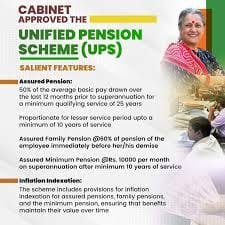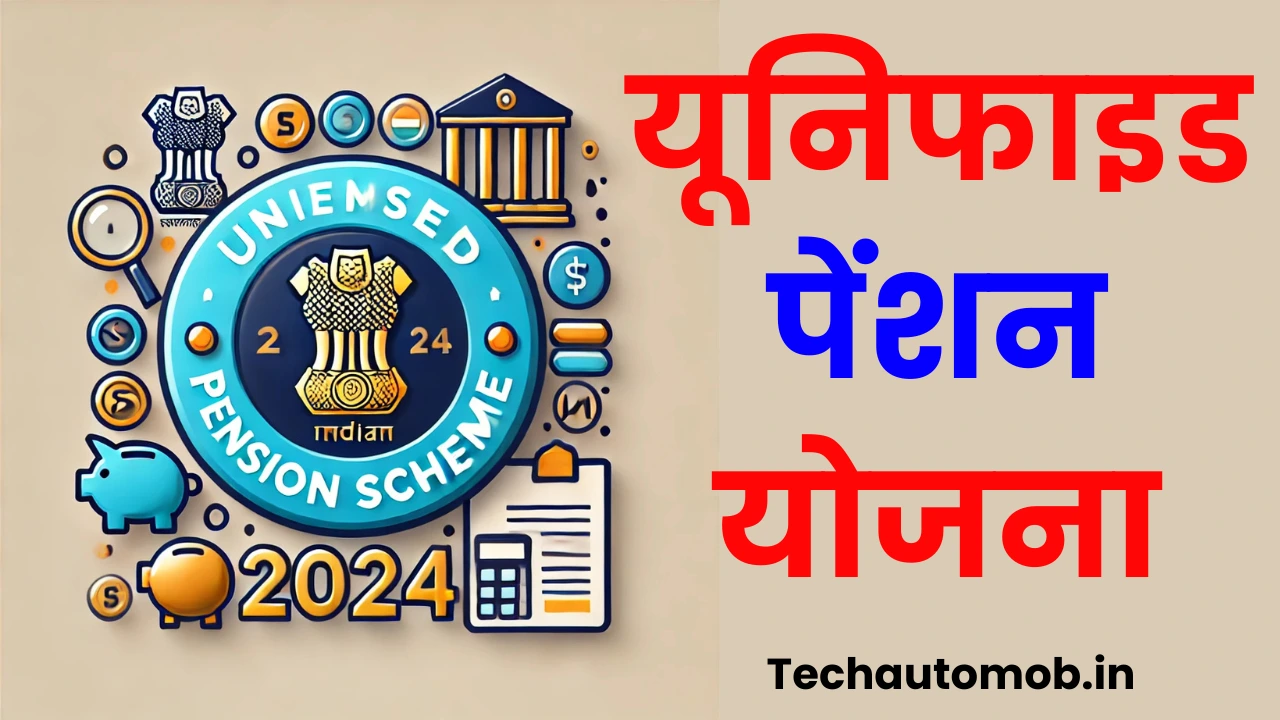Unified Pension Scheme:- The Unified Pension Scheme (UPS) is a significant initiative introduced by the Government of India on 24 August 2024, aimed at ensuring financial security and stability for government employees after retirement. This scheme is set to come into effect on 1 April 2025 and is designed to offer guaranteed pensions, addressing the limitations of the National Pension System (NPS). With a blend of features from both the Old Pension Scheme (OPS) and NPS, UPS seeks to provide sustainable benefits to employees and their families.
Table of Contents
What is the Unified Pension Scheme (UPS)?
The Unified Pension Scheme is a retirement-focused initiative tailored for central government employees. It aims to secure their financial well-being post-retirement by offering a fixed pension amount. Employees currently under the NPS framework can opt for UPS; however, this decision is irreversible. The scheme introduces a structured pension system with defined contributions from both employees and employers.
Unified Pension Scheme Highlights
| Feature | Details |
|---|---|
| Announcement Date | 24 August 2024 |
| Implementation Date | 1 April 2025 |
| Beneficiaries | Central Government Employees |
| Employee Contribution | 10% of Basic Pay + DA |
| Employer Contribution | 18.5% of Basic Pay + DA |
| Pension Benefit (25+ yrs) | 50% of the average salary for the last 12 months |
| Pension Benefit (10+ yrs) | Minimum ₹10,000 per month |
Maharashtra became the first state to adopt UPS for its employees on 25 August 2024, with other states likely to follow. If implemented nationwide, UPS could benefit over 90 lakh government employees, offering a robust alternative to NPS.
Eligibility for the Unified Pension Scheme
- Minimum Service Requirement:
- Employees with at least 10 years of service are eligible for a minimum pension of ₹10,000 per month.
- Employees with 25+ years of service receive 50% of their average salary for the last 12 months.
- Applicable Employees:
- Government employees covered under the National Pension System (NPS).
- Employees opting for Voluntary Retirement Scheme (VRS).
- State Employees:
- State governments can choose to adopt UPS for their employees.
Benefits of the Unified Pension Sachems
- Guaranteed Pension:
- Employees with over 25 years of service are assured of receiving 50% of their last 12 months’ average salary as a pension.
- Employees with service between 10 to 25 years receive proportional benefits.
- Employer Contribution:
- The government contributes 18.5% of the employee’s basic pay + DA to the pension fund, higher than NPS contributions.
- Inflation Protection:
- Pensions are adjusted for inflation through Dearness Relief (DR) based on the AICPI-IW Index.
- Family Pension:
- After the death of the pensioner, the spouse receives 60% of the pension amount.
- Lump-Sum Payment:
- At the time of retirement, employees are eligible for a one-time payment equivalent to 1/10th of their monthly salary for every six months of service.
Unified Pension Scheme vs. National Pension System
| Feature | Unified Pension Scheme (UPS) | National Pension System (NPS) |
|---|---|---|
| Employer Contribution | 18.5% of Basic Pay + DA | 14% of Basic Pay + DA |
| Pension Guarantee | 50% of the last 12 months’ average salary | Market-linked, no fixed guarantee |
| Minimum Pension | ₹10,000 per month | Depends on market performance |
| Family Pension | 60% of the pension amount | Based on investment fund performance |
| Inflation Adjustment | Yes (via DR) | Not Available |
| Lump-Sum Benefit | Additional one-time retirement payment | Up to 60% corpus withdrawal allowed |
Latest News and Updates
- Maharashtra Leads Adoption: Maharashtra has become the first state to implement UPS for its employees, effective 25 August 2024.
- State-Level Implementation: Other states are expected to adopt this scheme, potentially benefiting millions of state employees alongside central government workers.
Unified Pension Scheme Notification PDF
The Unified Pension Scheme (UPS) notification PDF was officially released by the Indian Government on August 24, 2024. The document provides comprehensive details about the scheme, including eligibility criteria, benefits, and the financial contributions required from both employees and employers. This PDF serves as an important resource for government employees and policymakers, offering clarity on the scheme’s features and implementation process.
Unified Pension Scheme in India
The Unified Pension Scheme (UPS) is a revolutionary retirement benefit program introduced in India. Set to be implemented from April 1, 2025, this scheme aims to provide financial security, stability, and dignity to central and state government employees after retirement. By balancing the best aspects of the Old Pension Scheme (OPS) and the National Pension System (NPS), it offers a robust alternative for retirement planning.

Unified Pension Scheme in Hindi
In Hindi, the Unified Pension Scheme is referred to as एकीकृत पेंशन योजना. This initiative by the Indian Government is tailored to ensure financial stability for employees post-retirement. The scheme’s features, including minimum guaranteed pensions and inflation-adjusted benefits, have been explained in various government-issued documents and notifications in Hindi, making it accessible to a broader audience.
Unified Pension Scheme UPSC
For UPSC aspirants, the Unified Pension Scheme holds significance as a topic under governance, social justice, and economic reforms. The scheme represents a key step toward improving India’s social security framework. It’s an essential topic for understanding public administration and government policies aimed at the welfare of employees.
Unified Pension Scheme vs Old Pension Scheme
The Unified Pension Scheme (UPS) differs from the Old Pension Scheme (OPS) in several ways:
| Aspect | UPS | OPS |
|---|---|---|
| Employer Contribution | 18.5% of basic salary + DA | Not applicable |
| Minimum Pension | ₹10,000/month | Guaranteed |
| Inflation Adjustment | Available via Dearness Relief (DR) | Available |
| Flexibility | Can’t opt out once selected | Not applicable |
This comparison highlights how UPS combines the best aspects of OPS with new features for improved financial security.
Unified Pension Scheme Details PDF
The Unified Pension Scheme Details PDF is a comprehensive document containing vital information about the scheme. It outlines aspects such as eligibility, employer and employee contributions, pension benefits, and conditions for opting into the scheme. It is a must-read for central and state government employees considering a shift from NPS or OPS.
Unified Pension Scheme Calculator
The Unified Pension Scheme calculator is a digital tool designed to help employees estimate their pension benefits under the UPS framework. It considers parameters such as years of service, average basic salary, and dearness allowance to provide accurate projections of monthly pension and lump-sum benefits.
Unified Pension Scheme Drishti IAS
Drishti IAS, a popular platform for UPSC preparation, provides in-depth analysis and insights on the Unified Pension Scheme. Their resources include explanatory videos, articles, and mock tests covering the scheme’s features, objectives, and its implications on governance and the Indian economy. These materials are beneficial for aspirants preparing for both prelims and mains exams.
Why is the Unified Pension Scheme Special?
The Unified Pension Scheme brings together the best features of OPS and NPS to ensure a balanced and secure retirement plan. With guaranteed pensions, inflation-linked adjustments, and higher employer contributions, it sets a new standard for employee welfare. Additionally, it offers comprehensive family security through assured family pensions, making it a holistic retirement solution.
FAQs About the Unified Pension Scheme
- What is the Unified Pension Scheme?
The Unified Pension Scheme (UPS) is a retirement benefit program introduced by the Indian Government to provide financial security to central and state government employees. It merges the benefits of the Old Pension Scheme (OPS) and National Pension System (NPS) while introducing features like guaranteed pensions and inflation adjustments. - Who is eligible for the Unified Pension Scheme?
The scheme is applicable to central and state government employees hired after the implementation of NPS in 2004. Employees under NPS have the option to switch to the Unified Pension Scheme, provided they meet specific eligibility criteria outlined in the scheme’s notification. - How does the Unified Pension Scheme differ from NPS?
Unlike NPS, which is a market-linked system, the Unified Pension Scheme offers a minimum guaranteed pension and inflation-linked adjustments through dearness relief. It also includes fixed employer contributions and provides better financial security for retirees. - What is the minimum pension guaranteed under the Unified Pension Scheme?
The minimum pension guaranteed under the Unified Pension Scheme is ₹10,000 per month, ensuring a stable post-retirement income for government employees. - How can employees calculate their pension benefits under the Unified Pension Scheme?
Employees can use the Unified Pension Scheme calculator, which considers factors like basic salary, dearness allowance, and years of service to estimate their pension benefits. This tool is available online through government portals and helps employees plan for their retirement effectively.
Summary
The Unified Pension Scheme (UPS), launching on 1 April 2025, represents a transformative step toward ensuring financial security for government employees post-retirement. With benefits like guaranteed pensions, inflation protection, and lump-sum payments, it stands as a robust alternative to the NPS. Its adoption by states like Maharashtra further underscores its potential to improve the lives of millions of employees nationwide.



